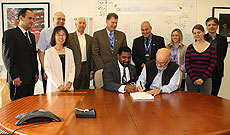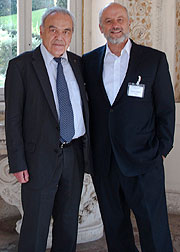|
Have a safe day!
Tuesday, Nov. 1
3:30 p.m.
DIRECTOR'S COFFEE BREAK - 2nd Flr X-Over
4 p.m.
Accelerator Physics and Technology Seminar - One West
Speaker: Sergiy Gladchenko, University of Maryland
Title: Application of Superconducting Resonators for Study of Two Level Defect States in Dielectrics
Wednesday, Nov. 2
3:30 p.m.
DIRECTOR'S COFFEE BREAK - 2nd Flr X-Over
4 p.m.
Fermilab Colloquim - One West
Speaker: Paul Steinhardt, Princeton University
Title: Once Upon a Time in Kamchatka: The Strange Search For Natural Quasicrystals
Click here for NALCAL,
a weekly calendar with links to additional information.
Upcoming conferences
|
|
Tuesday, Nov. 1
- Breakfast: Bagel sandwich
- Golden broccoli cheese soup
- Fish & chips
- Coconut crusted tilapia
- Burgundy beef tips
- La grande sandwich
- Assorted sliced pizza
- Chicken fajitas
Wilson Hall Cafe Menu
|
|
Wednesday, Nov. 2
Lunch
- Bourbon glazed salmon
- Thai rice pilaf
- Sautéed pea pods
- Lemon Napoleon
Friday, Nov. 4
Dinner
Closed
Chez Leon Menu
Call x3524 to make your reservation.
|
|
"The Fabric of the Cosmos"
 |
|
A four-part series by PBS will premiere tomorrow. |
On Wednesday, Nov. 2, PBS will premiere a new four-part NOVA series entitled, “The Fabric of the Cosmos,” based on physicist Brian Greene’s book of the same name. Aiming to comprehensively explain modern physics through powerful imagery, the series mixes enthralling metaphors with informative interviews.
“We all learn about space and time as little children, so we assume that they are simple to understand,” said Craig Hogan, the head of the Center for Particle Astrophysics and one of several Fermilab scientists who appear throughout the series. “Nothing could be farther from the truth. The nature of space and time, and their relationship to matter and energy, are the deepest mysteries of physics.”
The first episode, “What is Space?”, explores the concept of space – the seemingly vast emptiness between two obviously solid objects. From the infinitesimal to the mind-bogglingly massive gaps, every part of inner and outer space is filled with something. It’s in this episode that viewers begin to learn about dark energy, which makes up about 70 percent of all space, yet has remained largely elusive.
“At Fermilab, we are building experiments to learn more about dark energy,” said Hogan. “For example, the Dark Energy Survey will start collecting data next year to find out what is causing the expansion of space on the largest cosmic scales to speed up with time.”
Airing on Nov. 9, “The Illusion of Time” is the second episode of the series. The modern concept of time – forward motion – is dismissed.
Read more
—Ashley WennersHerron
|
Fermilab contract extended
 |
|
On Sept. 29, the extension to the Fermilab contract with DOE was signed by Rory Simpson from the Fermi Site Office and Fermilab Director Pier Oddone. Also present were senior managers from Fermilab, Fermi Site Office and the DOE Office of High Energy Physics. Photo: Brad Hooker |
|
Dark matter, darker still: The cosmos' greatest mystery deepens
From Time, Oct. 26, 2011
Like Hollywood legends Audrey Hepburn and Katharine Hepburn, dark energy and dark matter are completely unrelated, even though they share a name. Dark energy, a force that makes the universe expand faster and faster all the time, is called dark because it's mysterious. Nobody knows what it is. Dark matter, on the other hand, a type of matter that outweighs ordinary stars and galaxies 5 to 1, is called dark because it's utterly invisible. We know it's there because its gravity yanks galaxies and stars around, but it neither emits nor reflects any light.
Both darks are a big deal in astronomy. The accelerating universe, the first evidence that dark energy exists, earned three physicists the Nobel Prize just a few weeks ago. But dark matter has somehow failed to impress the Nobel committee, even though the idea has been around a lot longer. In the 1930s, astronomer Fritz Zwicky first suggested that given how fast galaxies whip around in space, they ought to fly apart — and would, if there wasn't some invisible matter holding them gravitationally together. In the 1970s, physicists Vera Rubin and Kent Ford came in with stronger evidence for the existence of dark matter, but their work too was received with shrugs.
Read more
|
DOE announces 100 Gbps network
From TG Daily, Oct. 31, 2011
The US Department of Energy will next month demonstrate an upgrade to the ESnet academic network that will take its speed up to 100 Gbps.
The project – funded with $62 million raised through the 2009 economic stimulus law – is intended for research use but could pave the way for widespread commercial use of similar technology, the department says.
"While this breakthrough will make sharing information between our labs much more efficient, its potential goes far beyond that," says secretary of energy Steven Chu.
"This faster speed at which data can be shared could pioneer the next era of internet innovations, changing and improving our lives much like the original commercialization of the internet did in the mid-90s."
Read more
|
|
Vatican symposium
 |
|
Pier Oddone with Werner Arber, president of the Vatican Pontifical Academy of Sciences, who shared the 1978 Nobel Prize for the discovery of restriction enzymes and their application to problems of molecular genetics. |
I am attending a symposium titled “Subnuclear Physics: Past, Present and Future” organized at the Vatican Pontifical Academy of Sciences. It is the first time that a meeting on particle physics has taken place at the Pontifical Academy. The venue is a villa built in the 1500s inside the Vatican gardens, quite different from our usual particle physics meeting locations. Newspapers in Italy have picked up on the meeting with the usual sensationalistic headlines, such as: “The Vatican calls on physicists to understand the Superworld.” The discussions at the symposium, of course, are more modest and down to earth.
Preparing for the meeting has been an opportunity for me to reflect again on the huge contributions that Fermilab has made to our understanding of physics. I presented highlights of this work as well as a very compressed description of our future program – many results to make us all proud of our history and optimistic about the future.
In looking over the last few decades, the progress made in our understanding of the world around us has been remarkable. We have gone from the fog of the 1960s to the very sharp questions our field asks today. Our theoretical understanding has placed every experiment we have ever done using accelerators into a common framework. This framework allows us to calculate the foundation of events against which our search for new physics takes place. It also tells us the sensitivity to new physics that we might expect.
In conference after conference this year, the biggest piece in our understanding is still missing: new physics from the LHC. The performance of the LHC this year has been outstanding with six times more data than was considered likely - if we were lucky - a year ago. This level of data brings the LHC squarely into symmetry breaking territory. There were no new results presented at the Pontifical Academy symposium beyond those that were presented at the Lepton-Photon meeting in August. We are impatient to fill in the missing puzzle piece, but most likely we will have to wait until the set of winter conferences next March to get a new batch of results.
|
|